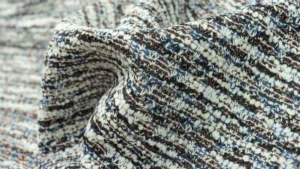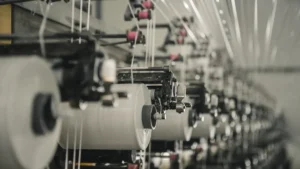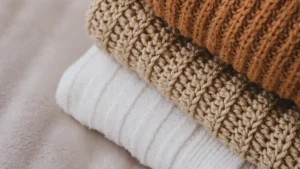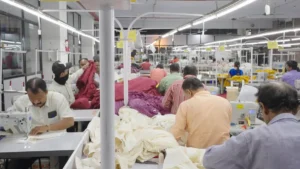
If you’re wondering what is a ponte knit, it’s a special type of fabric made using a double-knit technique. So, what is a ponte knit exactly? It’s created by tightly joining two layers of fabric, which gives ponte its firm and stable structure. You can recognize what is a ponte knit by its thick, smooth feel and the subtle horizontal lines across the surface. Often, ponte fabric blends rayon for softness, polyester or nylon for strength, and spandex for stretch. One of the reasons people ask what is a ponte knit is because it resists wrinkling and curling, making it easy to wear and care for. It’s soft, stretches just enough for comfort, and comes in various thicknesses so you can choose what is a ponte knit that best suits your needs. Many love ponte for pants, blazers, and dresses because it keeps its shape and always looks polished.
Ponte Fabric Characteristics | |
|---|---|
Structure | Double-knit, stable, and thick |
Texture | Smooth with subtle ribbing |
Stretch | Moderate with good recovery |
Wrinkle Resistance | High |
Key Takeaways
Ponte knit is a thick, stable double-knit fabric that resists wrinkles and keeps its shape well.
It blends fibers like polyester, rayon, and spandex to offer comfort, stretch, and durability.
Ponte works great for structured clothes like pants, blazers, and dresses that need to look polished.
Compared to other knits, ponte is easier to sew because it does not curl or stretch too much.
Choosing ponte helps you make long-lasting, neat garments that feel comfortable and look sharp.
What is a Ponte Knit

Ponte Fabric Structure
When you ask, “what is a ponte knit,” you learn it has a special build. Ponte fabric is different because it is a double knit. This means two layers are made at the same time. Factories use a round knitting machine with two sets of needles. These needles make loops on both sides of the fabric. The loops lock together, so the layers stay joined. This makes ponte thick, dense, and steady. Ponte feels the same on both sides. It does not curl at the edges like single knits. Ponte de roma is a well-known type of ponte. It uses this way to make fabric twice as thick as regular jersey. The fabric looks smooth, feels strong, and keeps its shape.
Ponte knits often mix different fibers for better quality. Most ponte fabrics use man-made fibers like polyester, rayon, viscose, nylon, or polyamide. A little spandex is added for stretch and to stop creasing. This mix makes ponte soft, comfy, and simple to care for. You get a fabric that is tough and bends easily. It works well for many clothes.
Key Characteristics
You can tell ponte fabric by its special features. The top feels smooth and may have faint lines across it. Ponte knits stretch a bit, so they move with you but do not get loose. The fabric stretches both ways, so you feel good sitting or moving. Ponte also snaps back after being stretched.
One great thing about ponte is how steady it is. Tests show ponte knits are stronger and steadier than single knits. The edges do not curl when you cut ponte, so it is easy to sew. Ponte fabric does not wrinkle much, so your clothes look neat all day. The fabric keeps its shape, even after washing and wearing. These things make ponte a favorite for people who want clothes that look nice and last long.
Tip: If you want fabric that is easy to sew and keeps its shape, ponte is a smart pick.
Common Uses
You will see ponte fabric in lots of clothes. Designers like ponte for clothes that need to look sharp. Ponte de roma is a top choice for work clothes and basics. The fabric is thick and stretchy, so it is good for fitted styles.
Here are some clothes that work best with ponte:
Garment Type | Why Ponte is Used |
|---|---|
Ponte’s structure and stretch help make fitted or flared styles. | |
Pants and Leggings | The fabric is comfy and looks neat, great for work or casual days. |
Jackets and Blazers | Ponte keeps its shape and does not wrinkle, so it looks fancy. |
Tops and Blouses | Ponte’s soft feel and many uses fit both casual and dressy looks. |
Athleisure Wear | The stretch and comfort make ponte great for yoga pants and sportswear. |
You can see why ponte knits are a top choice for clothes that need to look nice and feel good. Ponte works for daily wear and special events. The fabric is strong, easy to care for, and keeps its shape, so it is a smart pick for many closets.
Other Common Knit Fabrics

When you explore the world of sewing, you will find many types of knit fabrics. Each one has its own structure, feel, and best uses. Here is a closer look at some popular types of knit fabrics and how they compare to ponte knit.
Jersey Knit
Jersey knit is one of the most common types of knit fabrics. You will notice it feels soft and smooth. The fabric stretches well and drapes nicely, which makes it perfect for T-shirts, dresses, and lightweight tops. Jersey knit edges curl when you cut them, and the fabric is less stable than ponte. Sewing jersey can be tricky because it moves around and stretches easily.
Knit Type | Structure & Feel | Stretch & Drape | Typical Uses |
|---|---|---|---|
Jersey Knit | Single knit, soft, smooth | Moderate stretch, fluid drape | T-shirts, dresses, tops |
Tip: Use a ballpoint needle when sewing jersey knit to avoid snags.
Interlock Knit
Interlock knit is a double-knit fabric, just like ponte. You will see that it looks the same on both sides and feels thicker than jersey. Interlock knit does not curl at the edges and offers more stability. It stretches well and drapes smoothly, making it great for high-quality T-shirts, dresses, and sportswear. Interlock is easier to sew than jersey but still softer than ponte.
Rib Knit
Rib knit has raised lines, or ribs, running up and down the fabric. You will find it very stretchy, especially across the ribs. Rib knit hugs the body and keeps its shape, so you often see it in cuffs, necklines, and waistbands. Some garments use rib knit for a snug fit. Rib knit is less stable than ponte but offers more stretch.
Double Knit (Non-Ponte)
Double knit (non-ponte) is another sturdy option among the types of knit fabrics. It has two layers, like ponte, but may use different fibers. Double knit feels thick and balanced, with a smooth surface. You can use it for structured garments like skirts and jackets. Double knit is stable and easy to sew, much like ponte.
French Terry
French terry stands out among the popular types of knit fabrics because of its looped back and smooth front. You will notice it feels soft and absorbs moisture well. French terry works best for sweatshirts, hoodies, and casual wear. It has moderate stretch and is easier to sew than jersey but not as stable as ponte.
Knit Type | Structure & Stability | Stretch & Drape | Common Uses |
|---|---|---|---|
Interlock Knit | Double-knit, stable | Good stretch, smooth drape | T-shirts, dresses, sportswear |
Rib Knit | Raised ribs, elastic | High stretch, snug fit | Cuffs, waistbands, fitted garments |
Double Knit | Double thickness, sturdy | Moderate stretch, structured drape | Skirts, jackets, structured pieces |
French Terry | Loops on back, smooth front | Moderate stretch, soft drape | Sweatshirts, hoodies, loungewear |
You will find that ponte knit is more stable and easier to sew than most other types of knit fabrics. Ponte holds its shape, resists curling, and gives you a polished look. Lighter knits like jersey and rib need more care when sewing because they stretch and move more.
Ponte Knit vs Other Knits
Ponte vs Jersey
When you compare ponte to jersey, you notice big differences in structure and use. Ponte is a double-knit fabric with two layers locked together. This makes ponte heavier, sturdier, and more durable than jersey. Jersey is a single-knit fabric. It feels lighter and stretches more. Ponte fabric resists wrinkling and keeps a smooth, strong feel. Jersey stretches in all directions and drapes softly, which works well for casual clothes like T-shirts and lightweight dresses.
Ponte gives you moderate stretch, but not as much as jersey. You get more stability with ponte, so your clothes hold their shape. Ponte works best for structured garments like pants, blazers, and fitted dresses. Jersey fits best for relaxed, everyday wear. If you want a fabric that is easy to sew and keeps its shape, ponte is a smart choice. Jersey can be tricky to sew because it curls at the edges and stretches a lot.
Note: Ponte is heavier and more stable, while jersey is lighter and more elastic. Ponte is perfect for tailored, professional looks. Jersey is best for soft, casual styles.
Ponte vs Interlock
Ponte and interlock are both double knits, but they feel different when you touch them. Ponte fabric is thick and firm. Interlock is also thick, but it feels softer and lighter than ponte. Both fabrics do not curl at the edges, so they are easy to sew. Ponte gives you a structured drape, which means your clothes look crisp and hold their shape. Interlock drapes more softly and feels smooth on both sides.
Here is a table to help you see the differences:
Attribute | Ponte Knit | Interlock Knit |
|---|---|---|
Fabric Type | Thick, double knit | Double knit, two rows of stitches |
Thickness | Thick, firm | Thicker than jersey, softer than ponte |
Stability | Firm, stable, subtle sheen | Stable, lies flat, does not curl |
Surface | Subtle sheen, elegant look | Smooth on both sides |
Drape | Structured, holds shape | Softer drape, lies flat |
Shaping Ability | Good for tailored garments | Focus on smoothness and comfort |
You will find ponte better for clothes that need shape, like blazers or pencil skirts. Interlock works well for soft T-shirts and dresses.
Ponte vs Rib Knit
Rib knit and ponte both belong to the double-knit family, but they act very differently. Rib knit has raised lines, or ribs, that run up and down the fabric. This gives rib knit a lot of stretch, especially across the ribs. You often see rib knit in cuffs, necklines, and waistbands because it hugs the body and bounces back after stretching.
Ponte, on the other hand, is much more stable. It does not stretch as much as rib knit. Ponte fabric holds its shape and does not lose form, even after many wears. Rib knit feels softer and more flexible, but ponte gives you a polished, structured look. If you want a garment that needs to keep its shape, like a fitted dress or jacket, ponte is the better choice. Rib knit is best for parts of clothing that need to stretch and return to size.
Tip: Use ponte for structure and rib knit for stretch and comfort in fitted areas.
Ponte vs Double Knit
Double knits come in many types, including ponte, interlock, and jacquard. Ponte stands out because it is thicker, more stable, and less stretchy than most other double knits. Ponte fabric uses a dense, warp double-knit construction. This gives you stability close to woven fabrics, but with some stretch. Ponte fabrics often need seams, closures, or darts for a good fit, just like woven clothes.
Other double knits, like interlock or rib, offer more stretch and sometimes different textures. For example, double-knit jacquards can have patterns on both sides. Thermal double knits feel softer and warmer but do not hold their shape as well as ponte. Ponte is medium to heavy weight and works best for dressy, structured garments like suits, blazers, trousers, and skirts. You will find ponte easier to sew because its edges do not roll or stretch out.
Note: Ponte gives you the best stability and structure among double knits. Choose ponte when you want your clothes to look sharp and last long.
Ponte vs French Terry
Ponte and French terry feel very different when you wear them. Ponte is dense, smooth, and stable. It resists wrinkles and gives you a little stretch. This makes ponte perfect for structured garments like tailored dresses, pants, and blazers. French terry is lighter and more breathable. It has a smooth front and a looped back, which feels soft and absorbs moisture.
You will find French terry in sweatshirts, hoodies, and loungewear. It stretches more than ponte and feels more relaxed. Ponte fabric is better for clothes that need to look neat and hold their shape. French terry is best for casual, flexible clothing where comfort comes first.
Callout: Ponte is your go-to for structure and polish. French terry is your pick for comfort and casual style.
Similarities Among Knit Fabrics
Comfort and Flexibility
You will notice that most knit fabrics, including ponte, feel soft and comfortable against your skin. The secret lies in their looped construction. This design gives knit fabrics a natural stretch and flexibility. Your clothes move with you, making it easy to bend, stretch, or sit without feeling restricted. Here are some key points about comfort and flexibility in knit fabrics:
Knit fabrics stretch and recover, so they fit your body well.
You can wear them for active days, lounging, or even at work.
The soft drape of knits gives you a relaxed yet stylish look.
Ponte knit adds extra stability and keeps its shape, but still feels comfortable.
Other knits like jersey, rib, and interlock also offer great stretch and comfort.
Tip: If you want clothes that feel good all day, knit fabrics are a smart choice.
Versatility
Knit fabrics stand out for their versatility. You can use them for many types of garments, from casual to dressy. The table below shows how different knits work for various clothing items:
Knit Type | Key Characteristics | Suitable Garments | Versatility Notes |
|---|---|---|---|
Ponte Knit (Double Knit) | Stable, medium to heavy, easy to sew | Tops, dresses, skirts, pants, jackets, leggings | Great for structured pieces and beginners |
Jersey Knit | Soft, light, breathable | T-shirts, dresses, tunics, cardigans, underwear | Works for most casual and lightweight garments |
Rib Knit | Ribbed, very stretchy | Cuffs, necklines, fitted tops, dresses | Perfect for fitted and stretchy details |
Thick, warm, less stretch | Sweaters, hoodies, hats, cardigans | Best for warm, cozy garments | |
French Terry | Soft, stable, looped back | Sweatshirts, hoodies, joggers, vests | Ideal for casual, comfortable outerwear |
You can see that knit fabrics adapt to many styles and needs. Whether you want a sharp blazer or a cozy hoodie, there is a knit fabric that fits your project.
Ease of Care
You will find that most knit fabrics are easy to care for. Ponte knit, for example, keeps its shape and resists pilling and fading. You can usually machine wash ponte on a delicate cycle and dry it flat to help it last longer. Other knits, like jersey or rib, also wash well but may need a bit more care to avoid stretching or pilling. Washing knits inside out and using cold water helps protect the fibers. Drying flat prevents garments from losing their shape. Heavy knits should be folded, while lighter ones can be hung. Most knits do not need much ironing, but if you do, use low heat and iron inside out.
Note: Always check the care label on your garment for the best results. Proper care keeps your knit clothes looking fresh and lasting longer.
Choosing the Right Knit
When to Use Ponte Fabric
You should choose ponte when you want a fabric that is stable, thick, and easy to sew. Ponte works best for pants, skirts, and light jackets because it holds its shape and resists wrinkling. If you want a garment that looks polished and lasts a long time, ponte is a smart pick. Ponte di Roma, a popular type, is soft and simple to handle. You can use ponte for softly tailored jackets, dresses, and cardigans. Ponte smooths out less toned areas and gives subtle shaping, making it great for wardrobe basics. Ponte also supports denser embroidery designs without stiffening or sagging. If you want to learn how to sew with ponte, start with simple patterns for pants or blazers.
When to Use Other Knits
Other knits work better for different needs. Jersey knit feels light and stretchy, so you can use it for T-shirts and casual dresses. Rib knit is very stretchy and fits well for cuffs or fitted tops. Interlock knit is thicker and stable, which makes it good for baby clothes or smooth tees. French terry is soft and warm, perfect for sweatshirts and joggers. If you want a drapey dress, rayon knit is a good choice, but it can be slippery to sew. Each knit has its own best use, so match the fabric to your project.
Tips for Selection
When you pick a knit fabric, think about these steps:
Check the type and fiber content. Ponte is thicker and more stable than cotton or rayon knits.
Test the stretch. Hold the fabric and stretch it across the width. Ponte has moderate stretch, while other knits may stretch more.
Look at recovery. Ponte snaps back after stretching, so your clothes keep their shape.
Pre-wash your fabric. Ponte and other knits can shrink, so wash before cutting.
Choose the right tools. Use a ballpoint needle and stretch thread for knits.
Plan your pattern layout. Make sure the stretch goes in the right direction for comfort.
🧵 Tip: Ponte is easy to sew and care for. If you want to know how to buy ponte, look for stable, medium to heavy-weight options. Always check the care label to learn how to care for ponte and keep your garments looking new.
Knit Type | Best Use | Key Feature |
|---|---|---|
Ponte | Pants, blazers, dresses | Stable, structured, smooth |
Jersey | T-shirts, casual dresses | Light, stretchy, drapey |
Rib | Cuffs, fitted tops | Very stretchy, hugs body |
Interlock | Tees, baby clothes | Thick, soft, stable |
French Terry | Sweatshirts, joggers | Soft, warm, looped back |
When you look at ponte and other knit fabrics, you notice some big differences and a few things that are the same.
Ponte is special because it is double-knit, does not wrinkle easily, and keeps its shape well.
Ponte gives more support and holds its form better than jersey or rib knits.
Ponte acts more like woven fabric, so it is easier to sew and great for clothes that need to look neat.
Ponte feels nice, stretches both ways, and has a smooth surface. You can use ponte for dresses, pants, skirts, and jackets that need to stay in shape. Many people pick ponte because it does not wrinkle much and lasts longer than lighter knits. Ponte is made with polyester, rayon, and spandex, so it is strong and can stretch.
Always check how much ponte stretches and how heavy it is before you start your project. Ponte works best when you use it for the right kind of clothing.
You should test how ponte stretches and snaps back before you cut it. Ponte’s special features make it a favorite for clothes that look sharp and hold up well. When you choose ponte, you get fabric that is comfy, strong, and stylish.
FAQ
What makes ponte different from other knit fabrics?
You will notice ponte feels thicker and more stable than most knits. Ponte does not curl at the edges. You can sew ponte easily. Ponte holds its shape and resists wrinkles, so your clothes look neat all day.
Can you use ponte for summer clothing?
You can use ponte for summer, but it works best for cooler days. Ponte feels heavier than jersey or lightweight knits. If you want a breathable fabric for hot weather, you might choose a lighter knit instead of ponte.
How do you care for ponte garments?
You should wash ponte in cold water on a gentle cycle. Lay ponte flat to dry. Ponte resists wrinkles, so you do not need to iron it often. Always check the care label before washing ponte to keep your clothes looking new.
Is ponte good for beginners who sew?
Ponte is a great choice if you are new to sewing. Ponte does not slip or stretch too much. You can cut ponte easily, and the edges do not curl. Ponte helps you make neat, professional-looking garments with less trouble.
Does ponte stretch enough for fitted clothes?
Ponte has moderate stretch, so you can use it for fitted dresses, pants, or skirts. Ponte moves with you but does not lose its shape. If you want a fabric that hugs your body and stays smooth, ponte is a smart pick.









